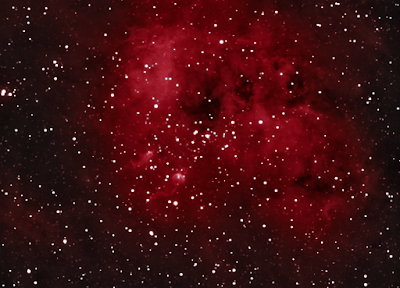.jpg)
A comparatively shallow view of this nebula looks like a bow tie. See?

But the deeper image shows the central star is actually surrounded by a boxy circle of gas (and dust?). The structure of the nebula is also bipolar, with something happening on the north and south. Just what is unclear. A stretch of gas swings out from the north, and from the south a leg is jutting out. Diffuse gas glows all around what appear to be edges of the circle. Compare my view with Don Goldman's
here, taken which much larger equipment.
Here's the riddle: Why does this planetary nebula glow so strongly in an image taken with an Ha filter? A planetary is usually formed when a dying star is dying because it has used up the hydrogen reserves necessary to burn like normal a star. It then swells up like a balloon and starts blowing the outermost layers into space. If the hydrogen left is not prominent in these stars, why does this nebula glow so brightly through an Ha filter, which focuses on the spectral line of ionized hydrogen gas?
There are two answers to this question. The first answer to this question is that my Ha filter lets through not just the important wavelength of ionized hydrogen at 656.3 nm. The filter I have lets through a range of wavelengths 13 nm wide. The 13 nm are roughly centered on the H-alpha line, but the range also includes that of ionized nitrogen at 658.4 nm. So actually everything taken through my Ha filter is Ha + NII.
The second answer is that some planetary nebulae actually contain a great deal of hydrogen. One study that split Ha and NII emissions of planetary nebulae in the Magellanic Clouds (two nearby galaxies) shows that some have more Ha and some have more NII. Some images from the study are
here. The upshot is that I do not know which NGC 40 shows more of, Ha or NII. Unless and until I get some even narrower narrowband filters (such as advertised
here), I will not be able to discover.
Imaging Scope: Orion 80ED & WO 0.8x II (f/6)
Imager: Atik 16
Exposure: 120" x 31
Filter: Astronomik 13nm Ha + NII
Capture Software: Nebulosity 2
Mount: Takahashi EM-10
Guiding Camera: DSI Pro
Guiding Software: PHD
Guiding Scope: No-name 60mm f/5
Date: Night of 9-26-09
Location: The Woodlands, TX
Processed with Nebulosity 2, Photoshop Elements 7 with Carboni Actions.
2.png) In this image, SII has been added in place of the green of the earlier image. The need for SII is proved by this excellent Cloudy Nights thread: http://tinyurl.com/yeqauur
In this image, SII has been added in place of the green of the earlier image. The need for SII is proved by this excellent Cloudy Nights thread: http://tinyurl.com/yeqauurHubPalSmlr-2.png)
HubPalSmlr.png)
RicksPalSmlr.png)
HubPal.png)
RicksPal.png)

MDL-HaCSIIMOIIIY.png)
Ha.png)
HaRed.png)
Ha.png)
HaRed.png)
HaOIIISII-M2.png)
HaOIIISII.png)
HaOIIISII-HSI.png)
HaOIIISII-1.png)
HaOIIISII-2.png)
HaOIIISII-4.png)
HaOIIIGr-St.png)
OIII.png)
OIIIGreen.png)
Ha.png)
HaRed.png)
OIII.png)
OIIIasGree.png)
Ha3.png)
HaFalseRed.png)
C.png)
FalseC.png)
.png)
Larger.png)
.png)
2.png)
.png)
.png)
C1.png)
Ha.png)
.png)
.png)
.jpg)

.jpg)
HaR.gif)
WS-LR.jpg)
1.JPG)
2.JPG)
3.JPG)

Crop.JPG)
.JPG)